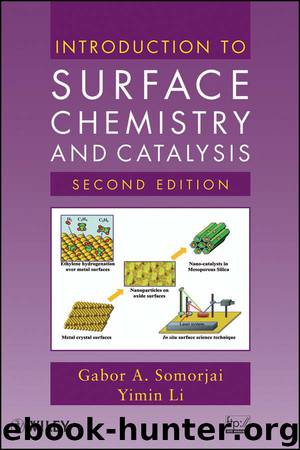Introduction to Surface Chemistry and Catalysis by Gabor A. Somorjai & Yimin Li

Author:Gabor A. Somorjai & Yimin Li [Somorjai, Gabor A.]
Language: eng
Format: mobi
Publisher: Wiley
Published: 2011-06-09T16:00:00+00:00
5.6.2 The Solid–Solid Interface
When two different metal surfaces are brought into contact, the surface space charges that were present at their interfaces with a vacuum will be modified. The electrons from the metal of lower work function will flow into the other metal until an interface potential develops that opposes further electron flow. This is called the contact potential and is related to the work function difference of the two metals (Fig. 5.7). The contact potential depends on the materials that make up the solid–solid interface, as well as on the temperature. This temperature dependence is used in thermocouple applications, where the reference junction is held at one temperature while the other junction is in contact with the sample. The temperature difference induces a potential (called the Seebeck effect), because electron flow from the hot to the cold junction. The potential can be calibrated to measure the temperature. Conversely, the application of an external potential between the two junctions can give rise to a temperature difference (Peltier effect) that can be used for heat removal (refrigeration).
Download
This site does not store any files on its server. We only index and link to content provided by other sites. Please contact the content providers to delete copyright contents if any and email us, we'll remove relevant links or contents immediately.
Alchemy and Alchemists by C. J. S. Thompson(3300)
The Elements by Theodore Gray(2855)
The Club by A.L. Brooks(2755)
How to Make Your Own Soap by Sally Hornsey(2746)
Drugs Unlimited by Mike Power(2487)
Wheels of Life by Anodea Judith(1922)
Cracking the Sat French Subject Test, 2013-2014 Edition by The Princeton Review(1768)
Perfume by Jean-Claude Ellena(1742)
The Flavor Matrix by James Briscione(1716)
Cracking the LSAT, 2012 Edition by Princeton Review(1697)
The Cosmic Machine: The Science That Runs Our Universe and the Story Behind It by Scott Bembenek(1693)
MCAT Physics and Math Review by Princeton Review(1570)
1000 Multiple-Choice Questions in Organic Chemistry by Organic Chemistry Academy(1568)
The Thing Around Your Neck by Chimamanda Ngozi Adichie(1489)
Cracking the SAT Premium Edition with 6 Practice Tests, 2017 by Princeton Review(1481)
Handbook of Modern Sensors by Jacob Fraden(1480)
Synchrotron Light Sources and Free-Electron Lasers by Eberhard J. Jaeschke Shaukat Khan Jochen R. Schneider & Jerome B. Hastings(1460)
A is for Arsenic: The Poisons of Agatha Christie (Bloomsbury Sigma) by Kathryn Harkup(1458)
Harry Potter All Books: 8 Books by J.k.rowling(1437)
